Hazım Kemal Ekenel
CAPE: A CLIP-Aware Pointing Ensemble of Complementary Heatmap Cues for Embodied Reference Understanding
Jul 29, 2025Abstract:We address the problem of Embodied Reference Understanding, which involves predicting the object that a person in the scene is referring to through both pointing gesture and language. Accurately identifying the referent requires multimodal understanding: integrating textual instructions, visual pointing, and scene context. However, existing methods often struggle to effectively leverage visual clues for disambiguation. We also observe that, while the referent is often aligned with the head-to-fingertip line, it occasionally aligns more closely with the wrist-to-fingertip line. Therefore, relying on a single line assumption can be overly simplistic and may lead to suboptimal performance. To address this, we propose a dual-model framework, where one model learns from the head-to-fingertip direction and the other from the wrist-to-fingertip direction. We further introduce a Gaussian ray heatmap representation of these lines and use them as input to provide a strong supervisory signal that encourages the model to better attend to pointing cues. To combine the strengths of both models, we present the CLIP-Aware Pointing Ensemble module, which performs a hybrid ensemble based on CLIP features. Additionally, we propose an object center prediction head as an auxiliary task to further enhance referent localization. We validate our approach through extensive experiments and analysis on the benchmark YouRefIt dataset, achieving an improvement of approximately 4 mAP at the 0.25 IoU threshold.
Mask-Free Audio-driven Talking Face Generation for Enhanced Visual Quality and Identity Preservation
Jul 28, 2025Abstract:Audio-Driven Talking Face Generation aims at generating realistic videos of talking faces, focusing on accurate audio-lip synchronization without deteriorating any identity-related visual details. Recent state-of-the-art methods are based on inpainting, meaning that the lower half of the input face is masked, and the model fills the masked region by generating lips aligned with the given audio. Hence, to preserve identity-related visual details from the lower half, these approaches additionally require an unmasked identity reference image randomly selected from the same video. However, this common masking strategy suffers from (1) information loss in the input faces, significantly affecting the networks' ability to preserve visual quality and identity details, (2) variation between identity reference and input image degrading reconstruction performance, and (3) the identity reference negatively impacting the model, causing unintended copying of elements unaligned with the audio. To address these issues, we propose a mask-free talking face generation approach while maintaining the 2D-based face editing task. Instead of masking the lower half, we transform the input images to have closed mouths, using a two-step landmark-based approach trained in an unpaired manner. Subsequently, we provide these edited but unmasked faces to a lip adaptation model alongside the audio to generate appropriate lip movements. Thus, our approach needs neither masked input images nor identity reference images. We conduct experiments on the benchmark LRS2 and HDTF datasets and perform various ablation studies to validate our contributions.
Assessing the Use of Face Swapping Methods as Face Anonymizers in Videos
May 27, 2025Abstract:The increasing demand for large-scale visual data, coupled with strict privacy regulations, has driven research into anonymization methods that hide personal identities without seriously degrading data quality. In this paper, we explore the potential of face swapping methods to preserve privacy in video data. Through extensive evaluations focusing on temporal consistency, anonymity strength, and visual fidelity, we find that face swapping techniques can produce consistent facial transitions and effectively hide identities. These results underscore the suitability of face swapping for privacy-preserving video applications and lay the groundwork for future advancements in anonymization focused face-swapping models.
Facial Attribute Based Text Guided Face Anonymization
May 27, 2025Abstract:The increasing prevalence of computer vision applications necessitates handling vast amounts of visual data, often containing personal information. While this technology offers significant benefits, it should not compromise privacy. Data privacy regulations emphasize the need for individual consent for processing personal data, hindering researchers' ability to collect high-quality datasets containing the faces of the individuals. This paper presents a deep learning-based face anonymization pipeline to overcome this challenge. Unlike most of the existing methods, our method leverages recent advancements in diffusion-based inpainting models, eliminating the need for training Generative Adversarial Networks. The pipeline employs a three-stage approach: face detection with RetinaNet, feature extraction with VGG-Face, and realistic face generation using the state-of-the-art BrushNet diffusion model. BrushNet utilizes the entire image, face masks, and text prompts specifying desired facial attributes like age, ethnicity, gender, and expression. This enables the generation of natural-looking images with unrecognizable individuals, facilitating the creation of privacy-compliant datasets for computer vision research.
A Survey on Class-Agnostic Counting: Advancements from Reference-Based to Open-World Text-Guided Approaches
Jan 31, 2025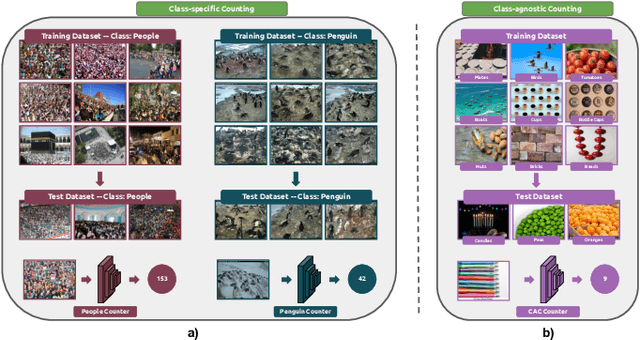
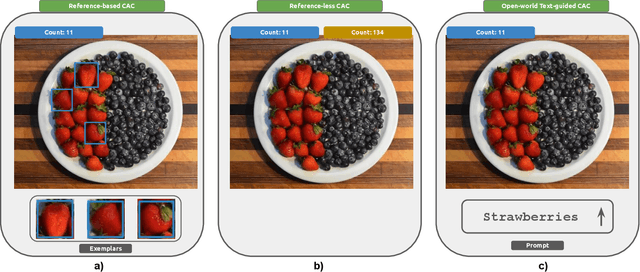


Abstract:Object counting has recently shifted towards class-agnostic counting (CAC), which addresses the challenge of counting objects across arbitrary categories, tackling a critical need in versatile counting systems. While humans effortlessly identify and count objects from diverse categories without prior knowledge, most counting methods remain restricted to enumerating instances of known classes, requiring extensive labeled datasets for training, and struggling under open-vocabulary settings. Conversely, CAC aims to count objects belonging to classes never seen during training, typically operating in a few-shot setting. In this paper, for the first time, we review advancements in CAC methodologies, categorizing them into three paradigms based on how target object classes can be specified: reference-based, reference-less, and open-world text-guided. Reference-based approaches have set performance benchmarks using exemplar-guided mechanisms. Reference-less methods eliminate exemplar dependency by leveraging inherent image patterns. Finally, open-world text-guided methods utilize vision-language models, enabling object class descriptions through textual prompts, representing a flexible and appealing solution. We analyze state-of-the-art techniques and we report their results on existing gold standard benchmarks, comparing their performance and identifying and discussing their strengths and limitations. Persistent challenges -- such as annotation dependency, scalability, and generalization -- are discussed, alongside future directions. We believe this survey serves as a valuable resource for researchers to understand the progressive developments and contributions over time and the current state-of-the-art of CAC, suggesting insights for future directions and challenges to be addressed.
Impact of Face Alignment on Face Image Quality
Dec 16, 2024Abstract:Face alignment is a crucial step in preparing face images for feature extraction in facial analysis tasks. For applications such as face recognition, facial expression recognition, and facial attribute classification, alignment is widely utilized during both training and inference to standardize the positions of key landmarks in the face. It is well known that the application and method of face alignment significantly affect the performance of facial analysis models. However, the impact of alignment on face image quality has not been thoroughly investigated. Current FIQA studies often assume alignment as a prerequisite but do not explicitly evaluate how alignment affects quality metrics, especially with the advent of modern deep learning-based detectors that integrate detection and landmark localization. To address this need, our study examines the impact of face alignment on face image quality scores. We conducted experiments on the LFW, IJB-B, and SCFace datasets, employing MTCNN and RetinaFace models for face detection and alignment. To evaluate face image quality, we utilized several assessment methods, including SER-FIQ, FaceQAN, DifFIQA, and SDD-FIQA. Our analysis included examining quality score distributions for the LFW and IJB-B datasets and analyzing average quality scores at varying distances in the SCFace dataset. Our findings reveal that face image quality assessment methods are sensitive to alignment. Moreover, this sensitivity increases under challenging real-life conditions, highlighting the importance of evaluating alignment's role in quality assessment.
Impact of Surface Reflections in Maritime Obstacle Detection
Oct 11, 2024
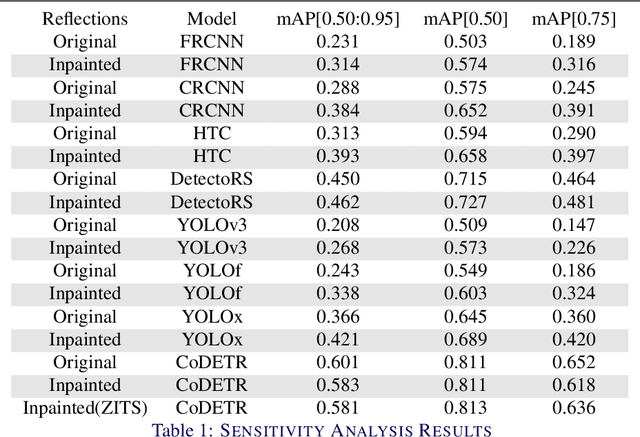
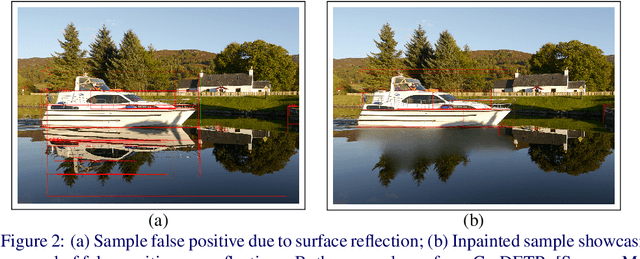
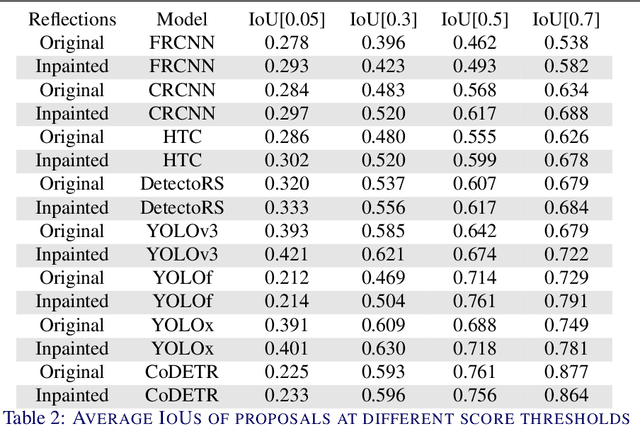
Abstract:Maritime obstacle detection aims to detect possible obstacles for autonomous driving of unmanned surface vehicles. In the context of maritime obstacle detection, the water surface can act like a mirror on certain circumstances, causing reflections on imagery. Previous works have indicated surface reflections as a source of false positives for object detectors in maritime obstacle detection tasks. In this work, we show that surface reflections indeed adversely affect detector performance. We measure the effect of reflections by testing on two custom datasets, which we make publicly available. The first one contains imagery with reflections, while in the second reflections are inpainted. We show that the reflections reduce mAP by 1.2 to 9.6 points across various detectors. To remove false positives on reflections, we propose a novel filtering approach named Heatmap Based Sliding Filter. We show that the proposed method reduces the total number of false positives by 34.64% while minimally affecting true positives. We also conduct qualitative analysis and show that the proposed method indeed removes false positives on the reflections. The datasets can be found on https://github.com/SamedYalcin/MRAD.
Analyzing the Feature Extractor Networks for Face Image Synthesis
Jun 04, 2024


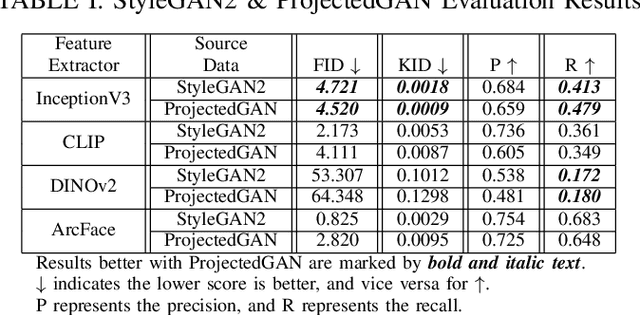
Abstract:Advancements like Generative Adversarial Networks have attracted the attention of researchers toward face image synthesis to generate ever more realistic images. Thereby, the need for the evaluation criteria to assess the realism of the generated images has become apparent. While FID utilized with InceptionV3 is one of the primary choices for benchmarking, concerns about InceptionV3's limitations for face images have emerged. This study investigates the behavior of diverse feature extractors -- InceptionV3, CLIP, DINOv2, and ArcFace -- considering a variety of metrics -- FID, KID, Precision\&Recall. While the FFHQ dataset is used as the target domain, as the source domains, the CelebA-HQ dataset and the synthetic datasets generated using StyleGAN2 and Projected FastGAN are used. Experiments include deep-down analysis of the features: $L_2$ normalization, model attention during extraction, and domain distributions in the feature space. We aim to give valuable insights into the behavior of feature extractors for evaluating face image synthesis methodologies. The code is publicly available at https://github.com/ThEnded32/AnalyzingFeatureExtractors.
Analyzing the Effect of Combined Degradations on Face Recognition
Jun 04, 2024



Abstract:A face recognition model is typically trained on large datasets of images that may be collected from controlled environments. This results in performance discrepancies when applied to real-world scenarios due to the domain gap between clean and in-the-wild images. Therefore, some researchers have investigated the robustness of these models by analyzing synthetic degradations. Yet, existing studies have mostly focused on single degradation factors, which may not fully capture the complexity of real-world degradations. This work addresses this problem by analyzing the impact of both single and combined degradations using a real-world degradation pipeline extended with under/over-exposure conditions. We use the LFW dataset for our experiments and assess the model's performance based on verification accuracy. Results reveal that single and combined degradations show dissimilar model behavior. The combined effect of degradation significantly lowers performance even if its single effect is negligible. This work emphasizes the importance of accounting for real-world complexity to assess the robustness of face recognition models in real-world settings. The code is publicly available at https://github.com/ThEnded32/AnalyzingCombinedDegradations.
Audio-Visual Speech Representation Expert for Enhanced Talking Face Video Generation and Evaluation
May 07, 2024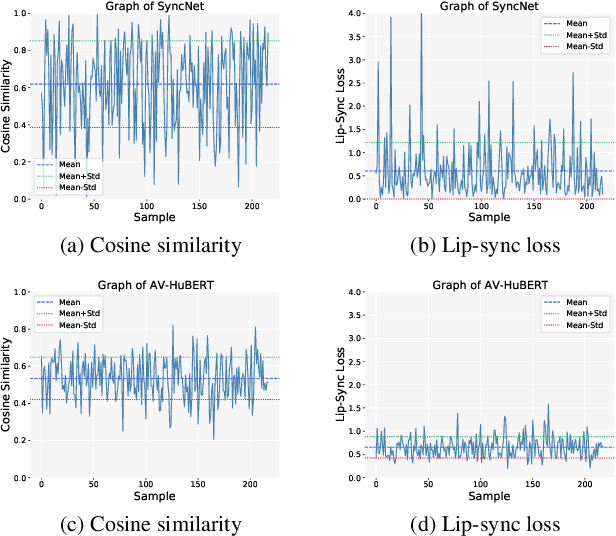
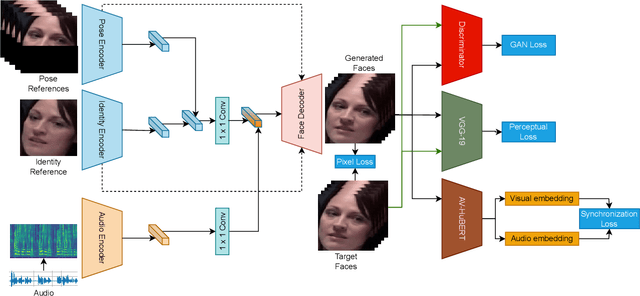

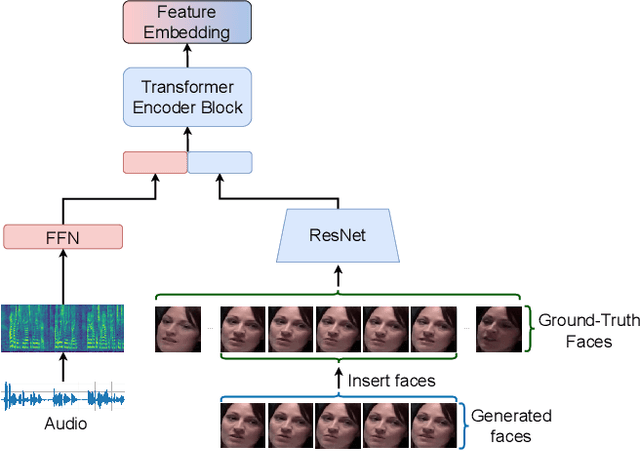
Abstract:In the task of talking face generation, the objective is to generate a face video with lips synchronized to the corresponding audio while preserving visual details and identity information. Current methods face the challenge of learning accurate lip synchronization while avoiding detrimental effects on visual quality, as well as robustly evaluating such synchronization. To tackle these problems, we propose utilizing an audio-visual speech representation expert (AV-HuBERT) for calculating lip synchronization loss during training. Moreover, leveraging AV-HuBERT's features, we introduce three novel lip synchronization evaluation metrics, aiming to provide a comprehensive assessment of lip synchronization performance. Experimental results, along with a detailed ablation study, demonstrate the effectiveness of our approach and the utility of the proposed evaluation metrics.
 Add to Chrome
Add to Chrome Add to Firefox
Add to Firefox Add to Edge
Add to Edge